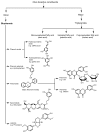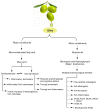Mediterranean and MIND Diets Containing Olive Biophenols Reduces the Prevalence of Alzheimer's Disease
- PMID: 31181669
- PMCID: PMC6600544
- DOI: 10.3390/ijms20112797
Mediterranean and MIND Diets Containing Olive Biophenols Reduces the Prevalence of Alzheimer's Disease
Abstract
The risk of Alzheimer's disease (AD) increases with nonmodifiable conditions including age and lack of effective efficacious pharmacotherapy. During the past decades, the non-pharmacotherapy mode of treatment of dietary modification received extensive attention in AD research. In order to reduce the AD pathology and cognitive decline, various dietary patterns have been attempted including caloric restriction (CR), dietary approaches to stop hypertension (DASH), ketogenic diets (KD), Mediterranean diet (MedDi) and Mediterranean-DASH diet Intervention for Neurological Delay (MIND) diet. Higher adherence to the MedDi diet was associated with decreases in cardiovascular and neurological disorders including AD and related cognitive decline. However, another emerging healthy dietary pattern MIND diet has also been associated with slower rates of cognitive decline and significant reduction of AD rate. Olive serves as one of the building block components of MedDi and MIND diets and the exerted potential health beneficial might be suggested due to the presence of its bioactive constituents such as oleic acids and phenolic compounds (biophenols). A few trials using medical food showed an optimal result in presymptomatic or early stages of AD. The review supports the notion that MedDi and MIND diets display potential for maintaining the cognitive function as nonpharmacological agents against AD pathology and proposed preventative mechanism through the presence of olive biophenols and presents the gaps along with the future directions.
Keywords: Alzheimer’s disease; Mediterranean diet; cognitive decline; olive biophenols.
Conflict of interest statement
The author declares no conflict of interest.
Figures
References
-
- Raina P., Santaguida P., Ismaila A., Patterson C., Cowan D., Levine M., Booker L., Oremus M. Effectiveness of cholinesterase inhibitors and memantine for treating dementia: Evidence review for a clinical practice guideline. Ann. Intern. Med. 2008;148:379–397. doi: 10.7326/0003-4819-148-5-200803040-00009. - DOI - PubMed
Publication types
MeSH terms
Substances
LinkOut - more resources
Full Text Sources
Medical
Miscellaneous




